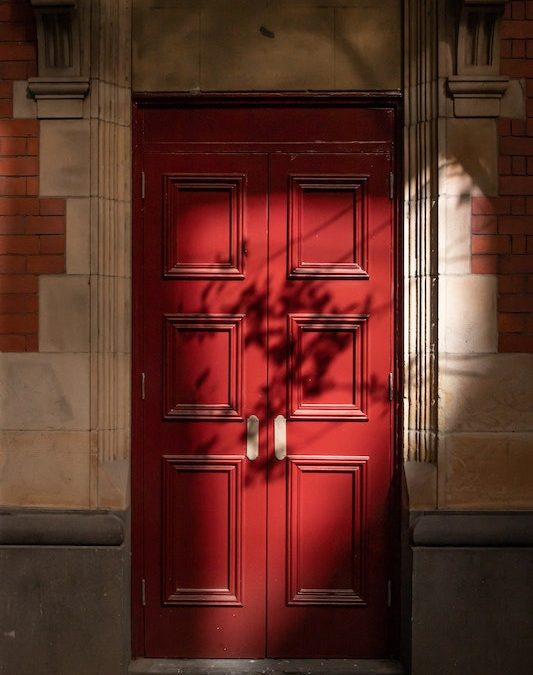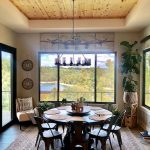Are you thinking about replacing the interior doors in your home? If so, then it’s dominant to know the difference between solid wood interior doors and hollow core doors. Home renovation specialists concur that determining the most suitable door type for your needs involves taking into account certain factors. Let’s dive into this article and explore the significant details about these two door types that can assist you in making a more informed decision.
Definition Of Solid Wood Doors
Solid wood doors are the perfect choice for creating a warm and inviting atmosphere in all spaces of your home. These wooden interior doors offer superior construction, strength, and durability compared to hollow core doors. It provides better soundproofing capabilities which make them ideal for bedrooms or living areas.
Solid wood doors are created by gluing multiple layers of hardwood together to form a single, sturdy piece, which makes up their design and construction. This type of manufacturing allows the door to be sturdier than other types of materials such as engineered wood or composites. As an added benefit, real wood can resist shrinking and warping over time better than any synthetic material.
What’s more, solid wood interior doors give homeowners greater flexibility when it comes to customization options since they can be stained or painted in virtually any color imaginable. Furthermore, various firms provide tailor-made wooden doors with elaborate designs and patterns, providing a distinctive touch to your entrance that set it apart from others.
Advantages Of Solid Wood Doors
Solid wood doors have many advantages for those looking to upgrade their home’s interior. For one, solid wood doors provide natural insulation from sound and temperature. They offer a level of durability that cannot be matched by hollow core counterparts. On top of that, they are available in a range of superior materials such as oak, pine, and others. This allows homeowners to find the perfect style to match their preferences.
When it comes to aesthetic appeal, there’s no denying the beauty of solid wood doors. The craftsmanship required to create these masterpieces is unparalleled; you’ll get a timeless look with any choice you make! Each door is unique due to its grain patterns and color variations – no two are identical! Moreover, if you ever become dissatisfied with your choice in the future, you can simply sand and stain the door for a fresh, new appearance.
In case you need something traditional or modern, rustic or chic – solid wood doors deliver every time! Not only do they last longer than hollow core options but they bring character into your space as well. With so much quality and versatility on display here, why settle for anything less?
Disadvantages Of Solid Wood Doors
It’s no wonder that solid wood doors are so popular – they look great and offer a level of privacy and security unmatched by other types of interior doors! But like anything else, there are some drawbacks to having a solid wood door. Here is what you need to know about the disadvantages of these beautiful wooden entrances:
- Price: Solid wood interior doors come with a hefty price tag. You will pay more for one than you would for any other type of door, such as hollow core or composite materials.
- High Maintenance: To keep your solid wood door looking its best, it requires frequent upkeep or refinishing.
- Weight: As compared to other types of interior doors, solid wood doors tend to be quite heavy due to their thick construction material.
- Installation Considerations: It takes skill and special tools to properly install a solid wood door into place; this means hiring professional help which is usually expensive.
So when considering if a solid wood door is right for you, weigh all factors carefully before making your final decision. From cost and maintenance requirements to installation considerations, make sure that you take everything into account before selecting this kind of entranceway for your home or office space.
Definition Of Hollow Core Doors
Hollow core doors are a type of door composed of two main components: a wooden frame and a thin veneer. The core of the door is made from either composite material or cardboard, depending on the manufacturer. Hollow core doors provide insulation but aren’t as soundproof or fire-resistant as solid wood interior doors. They’re also much lighter than solid wood interior doors, making them easier to install and move around if needed.
One advantage of hollow core doors is that they come in various styles and colors, so you can find one that fit with your existing décor. You can use paint or wallpaper to customize it further. Moreover, these types of doors tend to be less expensive than solid wood ones, making them an attractive option for many homeowners who are working within a budget.
On the other hand, while hollow core doors may look nice initially, they don’t hold up well over time due to their construction materials; dents and scratches accumulate quickly and cannot usually be fixed easily by sanding down like you can with solid wood interior doors. Further, because these types of doors contain no real structural support beyond the outer frame, extra braces must sometimes be added when installing them if used for an external doorway.
Hollow core doors offer an affordable solution for those looking for entryway access into their homes without breaking the bank – but bear in mind that there are limitations to what they can do compared to more substantial options available out there.
Properties Of Hollow Core Doors
When it comes to interior doors, hollow core doors are a cost-effective option that can provide many benefits over solid wood. Hollow core doors have their own set of characteristics that should be considered when selecting the right door for your home. Let’s take a look at these features in more detail:
CharacteristicDescriptionStrengthGenerally not as strong as solid wood core Material TypesUsually made from either particle board or fiberboardNoise Reduction CapabilitiesCan reduce noise transmission through walls and floors due to its construction design door Weight CapacityNot recommended for heavier objects such as cabinets and bookcases due to its lightweight constructionThermal Insulation PropertiesOffers insulation properties but generally not as good compared to other types of materials like solid wood or metal frames
Overall, hollow core doors offer an affordable way to upgrade the appearance of any room without sacrificing too much soundproofing or thermal insulation capabilities. Their lightweight nature makes them easier to install than their heavy wooden counterparts. Furthermore, they come in various styles and finishes so you can find something that matches your decor perfectly. With all this in mind, if you’re looking for a reliable yet budget-friendly option, then hollow core doors may be just what you need!
Advantages Of Hollow Core Doors
Hollow core doors offer several advantages over solid wood interior doors. First, they are less expensive. Hollow core construction is generally easier to manufacture than solid wood and therefore costs less at the point of sale. Hollow core doors can be custom-sized to fit any door frame or opening, saving time and labor during installation.
Second, hollow core doors provide better soundproofing than their wooden counterparts. The air space within a hollow core door helps absorb noise from other rooms more effectively than a single sheet of wood does. This makes them ideal for use in noisy areas such as laundry rooms or children’s playrooms.
Hollow core doors are lighter and easier to install than solid wood doors, making them a great choice for DIYers who want to save money on professional installation services. Moreover, since these types of doors don’t require heavy tools or special skills for assembly, even novice do-it-yourselfers can handle their installation with relative ease. Many brands of hollow core doors have been fireproofed so that they meet building codes in some states – another advantage when it comes to safety considerations around the home.
Disadvantages Of Hollow Core Doors
When it comes to purchasing interior doors, one of the biggest considerations is if you choose solid wood or hollow core. While hollow core doors may seem like a cost-effective option, they come with certain drawbacks that you should be aware of before making your purchase. Here are five disadvantages of choosing a hollow core:
- Costly – Hollow core doors tend to require more maintenance and repair over time compared to solid wood, which can make them costly in the long run.
- Less Durable – Because these door frames are made from weaker materials such as particleboard and fiberboard, they lack the strength and durability of their solid counterparts. This makes them prone to warping and cracking over time.
- Poor Insulation – Due to their construction, hollow core doors provide less insulation than solid wood, resulting in higher energy costs in colder climates.
- Noisy – Because of their lightweight construction, hollow core doors often produce vibrations when closed or opened which can be disruptive if not properly insulated.
- Weak Frame – The frame around a hollow core door is much thinner than those used for solid wood doors and can easily become dented or damaged when exposed to large amounts of force.
Before deciding on an interior door solution for your home renovation project, think about the drawbacks associated with hollow core options so that you don’t end up with regretful purchases down the line. With quality craftsmanship and superior materials, solid wood doors offer increased durability and peace of mind that last through years of use – something no amount of money can buy!
Maintenance Tips For Long-Term Use
When it comes to the maintenance of solid wood and hollow core doors, there are a few key things you should know. With proper care, these two door types can offer long-term use with minimal hassle. Here is a comparison between the two so that you’ll be better equipped to make an informed decision when choosing which type of interior door for your home:
Door TypeMaintenance TipsLong-Term UseSolid WoodRegular cleaning & polishing Moisture-resistant sealant applied Inspections for signs of rot or damageable, stylish option Can last up to 20 years if properly maintainedHollow CoreVacuuming away dust accumulation Wipe down surfaces with a damp cloth regularly Keep hinges lubricated as needed easy installation process Generally lasts 10-15 years depending on the care taken
As you can see from this table, both solid wood and hollow core doors require regular upkeep to stay looking great and functioning well over time. Solid wood doors need more attention due to their susceptibility to water damage and warping; however, the boast higher durability than hollow core ones. On the other hand, hollow core offers easier installation but requires more frequent vacuuming, wiping down surfaces, and oiling hinges as part of its maintenance routine.
Remember, regardless of the door type you opt for, it’s crucial to maintain a regular cleaning and inspection routine to ensure its prolonged use.
Taking good care of your wooden doors will help them look beautiful while protecting them against potential damages caused by everyday wear and tear. So take some time each month to give your door an extra bit of TLC – it’ll pay off in the end!
Frequently Asked Questions
Is It Possible To Paint Hollow Core Doors?
If you plan on painting hollow core doors, there are several factors to keep in mind. While they can be painted, the results may not always look as good as those of solid wood interior doors. Here’s what you should know about painting hollow core doors and some tips on how to do it right:
1) Preparation is key: Before starting any paint job, make sure you have all the necessary materials for the job — sandpaper, primer, enamel-based paint and painter’s tape or masking tape if needed. Furthermore, it’s required to prepare your workspace by ensuring it is well-lit and clean to avoid difficulties with drips or uneven strokes while painting.
2) Choose your colors carefully: When choosing colors for your door, opt for something neutral like white or cream since these will go best with most home décors. Besides, choosing a semi-gloss finish is recommended as it can preserve the color’s brightness for a longer duration and provide an added shield against dust and dirt. Then, determine if you’d prefer to use brushes or spray cans – both have their pros and cons but whichever option works better for you is fine!
3) Get creative with techniques: To create different textures on your hollow core door while painting, try out various techniques such as stippling (dabbing at paint), sponging (using a sponge dipped in paint), or ragging (creating texture through cloth). With these methods, you can give your door a unique look that stands out from regular flatly painted surfaces.
Painting hollow core doors requires patience and attention to detail if done properly; however, with dedication and practice it won’t be long until you master this DIY art form! So why not get started today? Just keep in mind, – preparation is key; choose colors wisely; get creative with techniques – then enjoy the process of transforming dull items around your house into beautiful pieces of artwork!
Are Hollow Core Doors Fire Resistant?
This is a vital question to ask when considering home improvement options. Many homeowners assume that wood doors are the only way to confirm fire resistance, but hollow core doors can be just as safe – if not safer – than solid wood interior doors. While it’s true that wood doors have a higher safety rating and burn to rate, hollow core doors provide adequate protection against fire.
It seem counterintuitive, but some hollow core doors offer superior fire resistance due to their design. For example, modern hollow core door designs feature steel reinforcements for increased stability and durability in the event of a fire. These reinforced areas act as barriers between rooms or floors which can help slow the spread of fires within your home. Furthermore, many of these products have been tested by Underwriters Laboratories (UL) and carry UL certification for improved fire safety ratings.
While there will always be some debate about whether solid wood or hollow core doors are better for overall home improvement projects, one thing is certain: both types of materials provide excellent protection from potential fires. As long as you select a product with the proper safety rating and burn rate certifications from a reputable manufacturer, you’ll be sure to get the peace of mind of knowing that your family is safe should a disaster strike.
Is There A Difference In Soundproofing Between Solid Wood Doors And Hollow Core Doors?
If you’re looking to improve your home’s soundproofing, it pays to know the difference between solid wood doors and hollow core doors. While both provide level of sound insulation, factors can affect their effectiveness in different ways.This article cover the dissimilarities in soundproofing capabilities of these two types of indoor doors, enabling you to make a knowledgeable decision about which one best suits your needs.
When comparing the soundproofing capabilities of solid wood doors versus hollow core doors, the cost may be a deciding factor. Generally speaking, solid wood doors tend to be more expensive than hollow core options; however, they offer better soundproofing due to their thicker construction material and tighter assembly process during installation. Choosing higher quality woods such as mahogany or oak will further improve its noise reduction properties over other materials like pine or plywood.
However, hollow core doors normally perform worse when it comes to door soundproofing because of their thinner construction and looser fit around frames and jambs, even if they are usually less expensive than their solid counterparts. Yet, depending on how much noise reduction you need from your interior doors, installing hollow core doors may still be the best option if staying within budget is a top goal for your home remodeling project.
No matter what type of door you choose for your residence, proper installation with weatherstripping along edges is vital for ensuring maximum acoustic performance. This extra measure can help keep unwanted sounds out and give you peace of mind knowing that you’ve taken all the necessary steps toward achieving excellent results.
Conclusion
When it comes to selecting the right door for your home, solid wood doors and hollow core doors both have their benefits. Solid wood interior doors are more expensive than hollow core doors, but they can add a luxurious look to any room in the house. While painting is possible with hollow core doors, fire resistance is one area where solid wood has an advantage since it’s naturally flame-retardant. Furthermore, soundproofing is another consideration; most experts agree that solid wood provides better noise reduction compared to hollow core options.
With careful research and planning ahead of time, you’ll be able to make an informed decision that fits your needs perfectly!
If you are looking for aesthetically appealing interior doors, discover the beauty of Moroccan woodworking today! Visit moroccanwoodworking.com and browse our exquisite collection of handmade woodcrafts. From intricate carvings to stunning furniture pieces, we have something for everyone. Shop now and add a touch of Moroccan elegance to your home decor. Don’t miss out, start exploring today!




